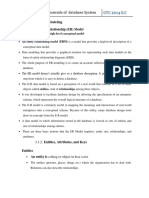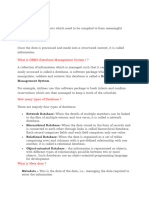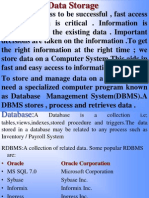SQL - Day 2: Structured Query Language
Uploaded by
Night KingSQL - Day 2: Structured Query Language
Uploaded by
Night KingStructured Query Language
SQL - Day 2
Agenda
Entity
Different types of attributes.
Multi valued attributes.
Simple/ Atomic attributes.
Compound/Composite attributes.
Derived attributes.
Stored attributes
Complex attributes
Key attributes
Non-Key attributes
Required attributes
Optional / null value attributes.
Database Management System SQL Rooman Technologies
What is an Entity?
Objects whose information can be stored inside a database are referred as
“Entity”.
Let’s look into few examples of entities in database.
Example 1:
Student
University
Database Professor Entities of University Database
Courses
Example 2:
Patients
Hospital
Doctors Entities of Hospital Database
Database
Tablets
Example 3:
Employees
Company
Department Entities of Company Database
Database
Clients
Database Management System SQL Rooman Technologies
Example 4:
Customers
Bank
Account Sections Entities of Company Database
Database
Transaction Details
Types of Entities:
1. Tangible Entity
2. Intangible Entity
Tangible Entity:
Tangible Entities are those entities which exist in the real world physically.
Example: student, professor, doctors, employees, clients, customers etc.
Intangible Entity:
Intangible Entity: Intangible Entities are those entities which exist only logically
and have no physical existence.
Example: Bank Account, courses, tablets, department, transaction details,
account sections.
Database Management System SQL Rooman Technologies
Let Us understand what is
Table
Rows
Columns
Cells
Table:
A table is a data structure that organizes information into rows and columns. It
can be used to both store and display data in a structured format.
For example, databases store data in tables so that information can be quickly
accessed.
Database Management System SQL Rooman Technologies
Rows:
A row is a series of data placed out horizontally in a table. It is a horizontal
arrangement of the objects, words, numbers, and data. In Row, data objects are
arranged face-to-face with lying next to each other on the straight line.
Rows are also called as tuples or record.
Database Management System SQL Rooman Technologies
Columns
A column is a vertical series of cells in a table. It is an arrangement of figures,
facts, words, etc.
Columns are mostly placed one after another in the continuous sequence. In a
table, columns are mostly separated from each other by lines, which help to
enhance readability and attractiveness.
Columns are also called as attributes.
Database Management System SQL Rooman Technologies
Cells:
The intersections of both rows and columns is known as cells.
Cells are also known as Fields.
Let’s Understand Different types of
Attributes or Columns.
Different types of attributes/columns available are:
Single valued attributes.
Multi valued attributes.
Simple/ Atomic attributes.
Compound/Composite attributes.
Derived attributes.
Stored attributes
Complex attributes
Key attributes
Non-Key attributes
Required attributes
Optional / null value attributes.
Database Management System SQL Rooman Technologies
Let’s understand each type of
attributes one by one…
Single valued attributes.
Single-valued attribute is an attribute that can have only a single value.
For example: A person can have only one age, only one gender, and a manufactured
part can have only one serial number.
Multi valued attributes.
An attribute that can hold multiple values is known as multivalued attribute. It is
represented with double ovals in an ER Diagram.
For example – A person can have more than one phone numbers or email ids so the
phone number or email id attributes are multivalued attribute.
Composite attribute
Composite attribute is an attribute where the values of that attribute can be
further subdivided into meaningful sub-parts."
For examples – Persons ‘Name’ is a composite attribute which can be stored as
first name, last name, middle initial.
‘Address’ is a composite attribute which can be divided into street number, city,
state, country etc.
Simple/ Atomic attributes.
Simple/ Atomic attributes is an attribute where the values of
that attribute cannot be further subdivided into sub-parts.
For examples – Date of birth of a person cannot be further divided into sub parts.
Database Management System SQL Rooman Technologies
Derived attribute
Derived attributes are the attributes that do not exist in the physical database,
but their values are derived from other attributes present in the database.
For example:
Age of a person can be derived from the date of birth attribute.
Duration of the course can be derived from start date of joining and end
date of course.
Stored attribute.
Stored attributes are the attributes whose values cannot be derived using other
attributes.
For Example - student_id, name, roll_no, course_Id, mobile number, email.
Complex attribute.
Complex Attribute is a type of attribute in database. It is formed by nesting
composite attributes and multi-valued attributes in arbitrary way. We can say
this as the both are in the attribute.
For Example- Address attribute, address can be a combination of all the other
attributes like street Number, Locality Number, city, state, country.
Key attribute.
A key attribute is the unique characteristic of the entity.
For Example- USN of Student, Bank Account Number, Employee Id.
Database Management System SQL Rooman Technologies
Non-Key Attribute.
Attributes that are not unique (attributes other than Key Attribute).
For Example- Name, Address, DOB, AGE.
Required Attribute.
A required attribute is an attribute that must have a value in it.
For Example- Name, Address, DOB, AGE.
Optional/null value Attribute.
Optional attribute may or may not have a value in it or it can be left blank.
For Example-Middle name of person.
Thank You
Database Management System SQL Rooman Technologies
You might also like
- Solution Manual For Data Abstraction Problem Solving With C Walls and Mirrors 6 e Frank M Carrano Timothy Henry100% (54)Solution Manual For Data Abstraction Problem Solving With C Walls and Mirrors 6 e Frank M Carrano Timothy Henry15 pages
- Data Structures & Algorithms Interview Questions You'll Most Likely Be AskedFrom EverandData Structures & Algorithms Interview Questions You'll Most Likely Be Asked1/5 (1)
- Database Systems: Types of Attributes, Entity Types, Entity Sets, Keys, and Value SetsNo ratings yetDatabase Systems: Types of Attributes, Entity Types, Entity Sets, Keys, and Value Sets20 pages
- APznzaZAdRdqCnNWCKFjnphlOfNhQgvEGGJ6a-BE4atiEnYehj9BhbkTt5R6YIe15vEKBNVOJMTep_ROvUSePeBH4-B2DVM0rZFlLqwOMNo ratings yetAPznzaZAdRdqCnNWCKFjnphlOfNhQgvEGGJ6a-BE4atiEnYehj9BhbkTt5R6YIe15vEKBNVOJMTep_ROvUSePeBH4-B2DVM0rZFlLqwOM39 pages
- Unit-2 Entity Relation Model (E-next.in)No ratings yetUnit-2 Entity Relation Model (E-next.in)20 pages
- Database Management System Revision GuideNo ratings yetDatabase Management System Revision Guide46 pages
- Difference Between Entity and Attribute in Database - Binary TermsNo ratings yetDifference Between Entity and Attribute in Database - Binary Terms9 pages
- Attributes:: Example: Student (Stu - Lastname, Stu - Middlename, Stu - FirstnameNo ratings yetAttributes:: Example: Student (Stu - Lastname, Stu - Middlename, Stu - Firstname30 pages
- High-Level Conceptual Data Models For Database Design: Unit - 2 Data Modelling Using Entity-Relationship ModelNo ratings yetHigh-Level Conceptual Data Models For Database Design: Unit - 2 Data Modelling Using Entity-Relationship Model17 pages
- Incrementation/Decrementation: Types of Increment and Decrement OperatorNo ratings yetIncrementation/Decrementation: Types of Increment and Decrement Operator5 pages
- Principles of Operating Systems and Its ApplicationsNo ratings yetPrinciples of Operating Systems and Its Applications7 pages
- Service Oriented Architecture For EnterpNo ratings yetService Oriented Architecture For Enterp7 pages
- Gujarat Technological University: Bachelor of Engineering Subject Code: 3160707No ratings yetGujarat Technological University: Bachelor of Engineering Subject Code: 31607074 pages
- JSP What Is Javaserver Pages?: Cgi Means "Common Gateway Interface"No ratings yetJSP What Is Javaserver Pages?: Cgi Means "Common Gateway Interface"9 pages
- Manipal University Jaipur: Object Orient C Programming - CA 1103 - 4 Credits - 3 1 0 4No ratings yetManipal University Jaipur: Object Orient C Programming - CA 1103 - 4 Credits - 3 1 0 47 pages






























































































